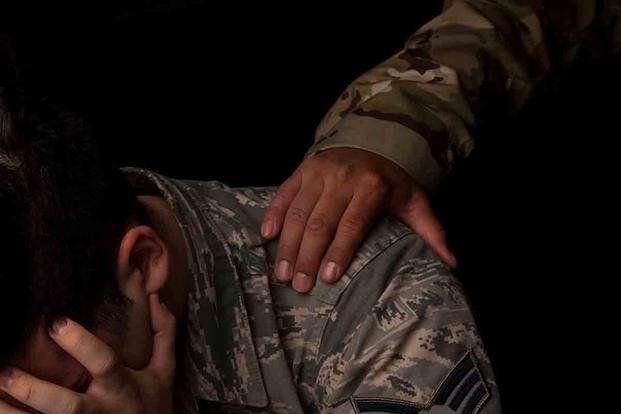Veteran suicide has been in decline since 2018, at the height of an epidemic that saw more than 18 U.S. military veterans end their own lives every day since the start of the Global War on Terror, according to the Department of Veterans Affairs 2022 National Veteran Suicide Prevention Annual Report.
There's still more work to be done. Veterans are still dying by suicide at an alarming rate, more than 16 every day, a rate 57% greater than the larger American population. To help further combat veteran suicide alongside existing VA and Department of Defense programs and end the stigma of seeking help, USAA has launched Face the Fight, its first social impact effort in the company's 101 years of operation.
Face the Fight is a coalition of philanthropic foundations, veteran-oriented nonprofit organizations and corporations that are pooling resources ($41 million to start) and sharing a nationwide concerted effort, with the goal of cutting the veteran suicide rate in half by 2030.
Face the Fight's Methods
USAA set up an external advisory committee of 13 subject-matter experts to help develop the early planning for Face the Fight, led by Katy Dondanville, a clinical psychologist at the Department of Psychiatry and Behavioral Sciences at the University of Texas Health Science Center in San Antonio. Her team is the academic alliance for the initiative.
"One of the biggest challenges around suicide prevention efforts is really figuring out how to take a public health approach, which means focusing outside of just health-care settings," Dondanville says. "A lot of different factors converge for an individual, and treatment will be different for an individual."
One important factor, Dondanville notes, is how veterans die by suicide. According to her team, 70% of them use a firearm. So storing those weapons becomes an important protective factor, and Face the Fight has worked that into its strategy.
"We have decided to focus on evidence-informed strategies from the Centers for Disease Control in suicide prevention," Dondanville told Military.com. "We are focused on protective environments, like voluntary firearms storage, ensuring that veterans who receive care outside the VA are getting evidence-informed interventions and scaling those interventions."
In 2021, more than two million veterans were authorized to seek treatment for various ailments in their local communities, outside of VA facilities. For those veterans looking for mental health care, Face the Fight wants to ensure its community facilities are properly trained to treat the unique issues of the veteran community. But not all veterans who contemplate suicide have mental health issues.
"We know that more than half of those that died by suicide don't have a mental health problem," says Dondanville. "That doesn't mean that it's under-diagnosed. It means that for some people, that there are a multitude of factors that lead someone to have suicidal thoughts; things like financial distress, legal problems and relationship problems."
To this end, the Resources section of the Face the Fight website is a hub for veterans experiencing the most common causes of suicidal ideation. It includes links to help veterans in crisis, but also get help with transition support, career guidance, financial assistance and more.
How Face the Fight Works
"We recognize that one company can't enter the arena of suicide prevention and expect to turn the tide single-handedly," says Justin Schmitt, USAA's assistant vice president of corporate responsibility. "Companies and corporate foundations can play a complementary role in veteran suicide prevention, destigmatize help-seeking behaviors, put the spotlight on resources that are proven effective and collaboratively fund interventions that reduce veteran suicide."
As a coalition of partners, Face the Fight pools philanthropic, donor-advised funding, vets potential nonprofit partners and then distributes those funds to select nonprofits whose missions align with Face the Fight's goals.
The initial philanthropic partnership that USAA and the USAA Foundation built includes The Humana Foundation and Reach Resilience, an Endeavors Foundation and technical support for building the coalition from the Elizabeth Dole Foundation. With an initial $41 million war chest, the goal is to help fund proven, effective and evidence-based programs so they can hire new clinicians, and grow and serve a larger portion of the military-veteran population over the next five years.
"The reason why we've been focusing on clinical and preparation is because one of the downsides to destigmatizing help-seeking can be a system that's unprepared for it," Dondanville says. "If we encourage help-seeking and people seek help, but there isn't good help, then they don't seek help anymore. When those folks seek that help, we want to ensure they're getting good help."
USAA is already distributing funds in the form of grants to three nonprofits with a focus on clinical care and that specialize in veteran suicide prevention: Cohen Veterans Network (which provides telehealth services, among others), The Headstrong Project and Stop Soldier Suicide to create a new and larger pipeline of clinicians trained in military cultural competency while building their capacities to take on more patients, with a national and international reach.
How to Get Involved with Face the Fight
Veterans and military-connected individuals who are looking for assistance can and should visit the Face the Fight website, which has a multitude of resources and direct links available to help the most common causes of distress, including mental health, financial issues, mentorship and even education and employment aid. There's also a crisis line available.
There are three categories of coalition members in Face the Fight. Philanthropic organizations or corporations that want to commit to end veteran suicide can donate to the donor-advised fund, but corporate entities can also provide in-kind donations, like airtime for public-service announcements.
Military-oriented nonprofits that believe they can meet Face the Fight's criteria and align with the mission can have a chance at joining the Face the Fight coalition. As part of the effort, USAA will stand up a scientific advisory committee to review annual VA and DoD suicide reports, as well as its own gathered information, and see how the program could be altered to be more effective.
"It's important to think about what we know now, what's changed, to get together and make recommendations on how we are able to respond to what's happening," says Schmitt. "We've been really thoughtful as we were planning this. We don't want to duplicate; we wanna compliment, and we wanna amplify. So I anticipate that we will evolve over time. That's the benefit of philanthropic support: It can be nimble, so we wanna be sure we respond in that way."
Nonprofits work with the military community in myriad ways. Some may have the ability to amplify the Face the Fight message, while others can further the destigmatization of help-seeking behavior. Some may even be looking to develop new suicide prevention programs. For those that think they'd be a good fit for the coalition, Face the Fight has an intake process.
Any nonprofit can express its interest in joining Face the Fight by sending an email to join@wefacethefight.org. USAA and the Elizabeth Dole Foundation will follow up those interested, explore how they can best contribute (if applicable) and then determine whether their goals align.
Veterans and service members experiencing a mental health emergency can call the Veteran Crisis Line, 988 and press 1. Help also is available by text, 838255, and via chat at VeteransCrisisLine.net.
-- Blake Stilwell can be reached at blake.stilwell@military.com. He can also be found on Facebook, Twitter, or on LinkedIn.
Want to Learn More About Military Life?
Whether you're thinking of joining the military, looking for post-military careers or keeping up with military life and benefits, Military.com has you covered. Subscribe to Military.com to have military news, updates and resources delivered directly to your inbox.












